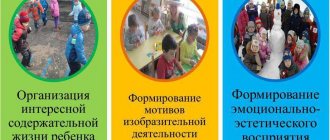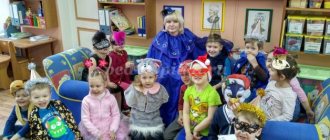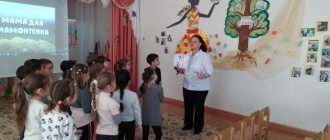Pedagogical technology "Club hour"
Alena Bogacheva
Pedagogical technology "Club hour"
Relevance
One of the main tasks of education that any teacher sets for himself is the socialization of pupils. This process is long, probably lasts a lifetime, but kindergarten is at its origins. It is here that children learn to make friends, play, begin to feel like members of a large children's team, and here the foundations of children's patriotic feelings are formed. The effectiveness of our children’s self-realization at school and in later life depends on how successfully the task of socialization is solved.
Introduction of new technologies for the socialization of children in preschool institutions. such technologies for the development of self-regulation of behavior in preschool children - “ Club Hour ”
.
The pedagogical technology “
Club Hour ” is that children can move around the entire kindergarten building for one hour, observing certain rules of behavior.
For the successful implementation of this technology there is a great desire and participation of the entire teaching staff in order to lay the foundations of a full-fledged socially successful personality during preschool childhood
The purpose of " Club Hour " technology
— positive socialization of the child in a preschool setting
Objectives of " Club Hour "
are:
instilling in children independence and responsibility for their actions;
spatial orientation training;
nurturing friendly relations between children of different ages, respectful attitude towards others;
promote the manifestation of initiative in caring for others, be grateful for help and signs of attention;
developing the ability to plan your actions and evaluate their results;
strengthening children’s skills to politely express their request and thank them for the service provided;
the development of children’s desires to express their attitude towards the environment, to independently find various speech means for this;
teaching children how to resolve controversial issues and resolve conflicts;
encouraging the child’s attempts to consciously share various impressions the teacher
acquiring one's own life experience (meaning formations)
experiences necessary for self-determination and self-regulation.
Types of " Club Hour "
:
"Free"
- when children move freely throughout the kindergarten
(indoors or outdoors)
and independently organize multi-age communication based on interests;
"Thematic"
- which are included in the situation of the month.
For example, in the “Space”
, this is a drawing competition on asphalt on space themes, building a spaceship,
“astronaut”
;
"Active"
- when the basis of K.Ch. is the child’s self-determination in choosing various types of activities, i.e., for example, in the gym there are outdoor games, in the music hall there is a performance, in one group they bake pies, in another they sew dresses for dolls, etc.
Conducting " Club Hour "
is preceded by a lot of preparatory work, primarily among parents and
teachers . Parents at the meeting are warned in advance that this event will be held in the preschool organization. They are informed about how this will affect children and how their safety will be ensured. Parents are given the opportunity to conduct master classes during “
Club Hour ” , as well as propose their own new topics, etc.
Educators and specialists preliminarily discuss and determine:
1. The theme of “ Club Hours ”
, K. Ch.’s long-term thematic plan for the six months.
2. Determine the frequency and duration of exercise training, usually once a week at the beginning of the program and 2-3 times a week thereafter. One of the main conditions for conducting a K.Ch. is its duration, namely at least 1 hour, because otherwise the children do not have time to develop their own life experience.
3. Determine the rules of behavior for children during “ Club Hour ”
4. Organizational aspects of conducting a competition are being developed.
5. Determine the order in which the K.Ch program begins. How many groups will participate in the first K.Ch., which groups, how to prepare children for the first K.Ch.
Determine the rules of behavior for children during “ Club Hour ”
Say "hello"
and
“goodbye”
when you enter another group.
If you took a toy to play, put it back when you leave.
Don't take toys from other children if they took it first.
Help conduct a lesson if it is suitable during the CC
Speak calmly.
Walk calmly.
Return to the group when the bell rings.
If you don’t want to go to other groups, you can stay in your group or return to it if you’re tired.
Organizational aspects of conducting a competition are being developed:
All kindergarten employees are notified of the time and day of the event. During the " Club Hour "
, the entrance doors to the garden are closed. Employees are at their workplaces and go about their daily business, waiting for the children to arrive. If possible, they communicate with the children, show them, tell them what they usually do here, and offer the children to help them. To achieve this, various activities are prepared in advance for visiting children.
Teachers determine the signal for the end of K.Ch., for example, the ringing of a bell, when the person in charge passes through all floors (groups), giving a sign to the children that it is time to return to their groups.
Determine the order in which the K.Ch program begins. How many groups will participate in the first K.Ch., which groups, how to prepare children for the first K.Ch.
Preliminary work is also carried out with children of the senior and preparatory groups:
· Firstly, a discussion is organized “What is “ Club Hour ”
, why is it needed, what will we do during the K.Ch. and who would like to go to it?”
· Secondly, we discuss what groups there are in kindergarten. Age of children in these groups and on which floor (wing)
they are.
· Thirdly, it is determined what kind of premises are available in the kindergarten. What are they called, who works there, what they do and what benefits they bring.
· Fourthly, a plan is issued (a map of what is happening where, if it is “thematic”
or
“active”
K. Ch.
Immediately before the first K.Ch., the children discuss all the rules; they are briefly repeated before each K.Ch. Then instructions are given: “Children, you can move around the entire building for one hour, observing the rules of behavior. And at the ringing of the bell you return to the group.”
After completing the K.Ch., all children participating, each in their own group, with a teacher, sit in a circle on the carpet. A candle is lit and meditative music is turned on. The discussion begins. The teacher makes sure that the children do not interrupt each other and speak in turns, patiently waiting until their turn comes.
-Where was the child?
- What did he remember?
— Does the child want to go there again and why?
— Did he plan to go somewhere before K. Ch.? Were you able to do this, if not, why?
— Did you manage to follow the rules, if not, then why?
The teacher records the problems that arise in children in the process of CC and discusses them with children and parents (at a suitable time, finding ways to solve them in joint activities.
After each K.Ch. at the pedagogical council, educators , teachers and staff exchange opinions on:
- what did the children do when they came to his territory, what was special in the children’s behavior?
- how did children who remained in their group react when guests came to them (a question for teachers,
— did the children follow the rules, and what prevented them from complying with them, were there any conflicts.
— what tasks need to be solved at the upcoming competition
Conclusion:
In general, regular C.C. once a week, already within 5 months, will allow us to record the following changes in children:
They will recognize most of the kindergarten children, begin to treat them more friendly, and begin to communicate their needs in more detail and openly not only to their teachers, but also to other kindergarten employees.
To summarize the above, it is important to note that with the help of such technologies, within the framework of socialization, the child’s idea of his immediate society is formed, that is, belonging to one or another group of people, etc.
“Club hour - as an effective means of socialization in preschool educational institutions”
- creative. Children of the pre-school group themselves organize all the activities at the “Club Hour” for all children.
Club hour can be held once a month in various forms: as an educational activity in the morning, as an activity in interest groups in the afternoon.
Preliminary work
To organize a club hour, you need to do some preliminary work. Teachers study the theoretical foundations of children's social and communicative development. Select appropriate methodological literature. Together they watch videos from work experience of how other teachers conduct club hours. Discuss the plan for the upcoming event, involving all kindergarten employees.
Then, at a group meeting, the teacher tells parents about the purpose and features of holding a club hour in kindergarten. The main emphasis should be on how children should behave during the event, what “penalties” are provided for violating the rules of behavior. General organizational and substantive issues are discussed jointly.
Next, the teacher organizes work with children in a group. Repeats with them the rules of behavior during the club hour, draws up reminders.
Rules of conduct during Club Hour
• Say “hello” when you enter another group and “goodbye” when you leave.
• If you took a toy to play, put it back when you leave.
• Do not take toys away from other children if they took it first.
• Help teach a class during club hour.
• Speak and walk calmly.
• Return to the group when the bell rings.
• If you don’t want to go to other groups, you can stay in your group.
• If you are tired, you can return to your group.
The teacher, together with the preschoolers, makes special bags. Children put tokens and notepads in them for writing. The tokens lying in each child’s purse are calculation material. If children violate the rules of conduct, the supervising adults take tokens from them: the first time the child violated the rules - one token, the second time - the second token and deprive the child of participation in the next club hour, the third time - the third token and deprive the child of participation in the next two club hours. hours.
Holding a club hour
Children of primary, middle and senior preschool age, parents, and teachers participate in the club hour.
In the introductory part, the teacher distributes plans indicating places where participants can go. The places are indicated by symbols.
At the signal of the bell, children leave the group, move freely around the premises, enter any places that are interesting to them, marked with a conventional image, where educational activities are organized for them.
Master class Topic: “Club hour - a modern technology for effective socialization”
Master Class
Topic: “Club hour - modern technology for effective socialization”
Master class leader:
teacher of MBOU NOSH village. Northern
Krasnoperova Tatyana Vladimirovna
Target:
to increase the pedagogical competence of teachers in the field of successful socialization of preschool children, with the involvement of subjects of the pedagogical process in an educational institution: children, teachers, parents. Introduce modern technology of effective socialization - “Club Hour”.
Handout:
(Whatman paper 3 pcs., crayons, markers, glue, colored paper, scissors, suggested topics with goals and objectives, bell, candle).
Teacher:
Good afternoon, dear colleagues, allow me to introduce myself – Romanova S.V. teacher of MBOU NOSH village Severny.
Our institution has successfully implemented a project on ethnocultural education “Different peoples - different traditions.” One of the directions of the project was called “Everything beautiful is for children.” This area included activities on a variety of topics, including all areas of child development. And we would like to draw your attention to one of the technologies for the effective socialization of preschoolers - “Club Hour”.
1.Speech. Technology – “Club Hour”
The pedagogical technology “Club Hour” is that children can move around the entire building (or area) of the kindergarten for one hour, observing certain rules of behavior, and return to the group when the bell rings.
We have identified the main goals of the “Club Hour”:
—instill independence and responsibility in children;
—teach children to navigate in space;
—cultivate friendly relations between children of different ages, respectful attitude towards others;
-develop the ability to take initiative in caring for others, to be grateful for help and signs of attention;
-help to gain life experience) necessary for self-determination and self-regulation.
The “Club Hour” is preceded by preparatory work: handbags and tokens of 3 pieces are made. for each child, a diagram of the institution, a bell. Parents are notified in advance about the club hour.
Educators and specialists preliminarily discuss and determine:
1). subject matter
"Club hour" and participants. This is necessary, since “Club Hour” can be carried out in various forms: as an educational activity in the morning, as an activity in interest groups in the evening, as one of the forms of organizing a walk or leisure time. The following types of “Club Hour” can be distinguished:
-free. Children move freely throughout the entire territory of the kindergarten (indoors or outdoors) and independently organize communication of different ages based on interests without the help of adults;
-thematic. In this case, "Club hours" are included in the situation of the month.
-active. This type of “Club Hour” is based on the child’s self-determination in choosing various types of activities.
-creative. Children of the pre-school group themselves organize all the activities at the “Club Hour” for all children.
2).
frequency and duration
of the “Club Hour”. Events typically take place once a week at the beginning and 2-3 times a week thereafter. One of the main conditions for holding a “Club Hour” is its duration, namely at least 1 hour, since otherwise children do not have time to gain their own life experience;
3).
The rules of behavior for children
during the “Club Hour” are discussed and established together with the children in the group. You can hang it...
4). organizational issues
"Club hour". All kindergarten employees are warned about the day and time of the event. The event goes like this. The entrance doors to the garden are closed. Employees are at their workplaces and go about their daily business, waiting for the children to arrive. Preparing a variety of activities in advance for visiting children. At the end of the “Club Hour”, the person in charge goes through all floors (groups), for example, with a bell, giving a signal that it is time to return to the groups;
Preliminary work is also carried out with children of the senior and preparatory groups:
· a discussion is organized during which older preschoolers learn what “Club Hour” is and why it is needed, what they will do during this event, and who would like to go to it;
· it is discussed what groups there are in the kindergarten, the age of the children in these groups and on what floor (wing) they are located;
· it explains what rooms there are in the kindergarten, what they are called, who works there, what they do and what benefits they bring;
· a plan (map) is issued of what is happening and where, depending on what type of “Club Hour” is planned - thematic, activity-based or creative;
· penalties are established for non-compliance with the rules. Each child carries a bag on his shoulder. Which contains three tokens. And for breaking the rules (bad behavior), the adult takes the token. If the child has no tokens left at the end of the club hour. Then he loses the opportunity to participate in the club hour next week.
· immediately before the “Club Hour”, the children discuss all the rules. A plan is issued - a map on which places in the preschool are marked where you can go, each child plans where he wants to go. Instructions are given: “Children, you can move around the entire building for one hour, observing the rules of behavior. And at the ringing of the bell you return to the group.”
After finishing
“Club hour”, all child participants, each in their own group, with a teacher, sit in a circle on the carpet. A candle is lit, meditative music is turned on, a discussion begins - a reflective circle. The teacher makes sure that the children do not interrupt each other and patiently wait for their turn to speak.
The following questions are discussed:
-Where was the child?
-What do you remember?;
-Do you want to go there again and why?;
-Did you plan to go somewhere before the “Club Hour”? Were you able to accomplish this, and if not, why not?
-Did you manage to follow the rules, if not, why?
The teacher records the problems that children have during the “Club Hour” and discusses them with children and parents (at a suitable time), finding ways to solve them in joint activities.
After
For each event, the pedagogical council discusses:
-what the children did when they came to his territory, what was special in the children’s behavior;
- how did the children who remained in their group react when guests came to them (a question for teachers);
- did the children follow the rules, and what prevented them from complying with them, were there any conflicts; -what problems need to be solved at the next “Club Hour”.
Would like to note. That in the places designated for the club hour, children are not particularly left to their own devices, various creative or educational work is carried out with the children, the freedom of the children lies in the fact that they can leave the office at any time and go to another place, which is indicated on the map.
2. Watch a video about the club hour.
3. Practical activities.
Teacher:
And now, I suggest you divide into three groups, each of which will choose a topic you like and try to develop your own club hour. Also, along with the topic, you are offered a goal and objectives, you can use them either fully or partially. In addition to the topic, purpose, tasks, you need to come up with what kind of activity the children will engage in when they come to any of the stations. This can be cognitive (informational), creative, productive, gaming, artistic, constructive, musical activity, but all of them must be united by a single theme and goal. At the end, each group will present us with a model (project) of their club hour and tell us what the children will do during the club hour. The presentation form can be any. For this you can use the proposed material. We will set the time for work at 15 minutes and 3 minutes for presenting your model.
4.Work in groups (15 minutes).
5. Presentation of club watch models (3 minutes each).
6. Reflective circle.
Teacher:
At the end of any club hour, a reflective circle is held, I also invite you to stand in the circle and, passing the candle, I ask you to briefly express your opinion whether this technology has aroused interest and whether you will use it in working with children, you can also supplement your answer with the following: in your opinion was the most attractive in our master class.
Club hour in the gym
The most important thing in raising a child is his socialization. For his full development, a child must be able to communicate with peers and adults. The development of communication skills plays a special, significant role in the overall development of children and their future lives.
Everyone knows that children learn about the world through play. Communication skills also develop beautifully through play.
The gym for preschool children is a favorite place to play. In active and sedentary games, the child develops motor skills, develops physically, morally and mentally. In games, children learn to interact with each other and develop the ability to communicate.
Subject specialists also took part in the implementation of the “Club Hour” technology in our preschool educational institution: a psychologist, a music director, a speech therapist and a physical education instructor.
The gym welcomes more children to Club Hour of different ages. These are children 5-6 years old and 6-7 years old. Children are very happy to choose what they would like to do when they come to the gym. The choice of activity takes place on Tuesday, and already on Friday we welcome children to the “Club Hour”. The desire of children is above all. The choice of what to do is theirs alone.
Holding a club hour in the gym has many advantages.
Firstly, it is a large space.
Secondly, there is a huge amount of sports equipment.
Thirdly, children can change the choice of game. One game can smoothly transition into another, and children can be divided into groups for games based on their interests.
In the gym, as well as in other places where Club Hours are held, there are rules. Children become familiar with the rules immediately when they come to the gym.
All equipment is available to children; they use it not only for its intended purpose, but also invent and fantasize it themselves. Gymnastic poles can turn into fishing rods, soft modules into a ship or a crane.
In games with children from other groups and other ages, children become more relaxed, sociable, and friendly. They learn to negotiate, come up with new games and activities, new rules.
At the end of the Club Hour, results are summed up, reflection is made, and new wishes are left for a future visit to the gym. Children independently, unaccompanied, disperse into groups.
In the gym, when they come to the “Club Hour”, children acquire new qualities, modest ones become more courageous and confident, children who do not know how to find contact become sociable and make new friends. Following the rules builds self-discipline.
At the pedagogical council, parent meetings, teachers and parents concluded about the enormous importance and advantage of the “Club Hour” technology. About big changes in the behavior of children, in their development, for the better.







